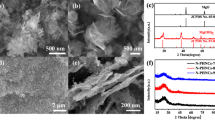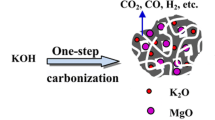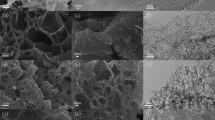Abstract
In this work, nitrogen-doped carbon with hierarchical porous and hollow sphere structure has been synthesized through a simple and facile route of spray drying using glycine as the nitrogen-containing carbon source. After KOH activation, the prepared material (NHPCA) shows a large specific surface area of 962 m2 g−1 with moderate N-doping of 5.74% and exhibits a high specific capacitance of 271 F g−1 in 6 M KOH electrolyte at 1.0 A g−1, remarkable rate capability and particularly stable cycling performance with no significant specific capacitance drop after 10000 cycles at 1.0 A g−1. The excellent electrochemical properties come from the unique structure and the doping of nitrogen. The hierarchical pore structure improves the efficiency of electrolyte ions transport, and diffusion and the hollow sphere structure further facilitates mass transport. The doping of nitrogen increases the total capacitance by providing redox pseudo-capacitance. The results indicate the as-prepared nitrogen-doped carbon with hierarchical porous and hollow sphere structure can be used as a hopeful candidate for an efficient electrode of commercial supercapacitors devices.



Similar content being viewed by others
References
Sun J, Niu J, Liu M et al (2018) Biomass-derived nitrogen-doped porous carbons with tailored hierarchical porosity and high specific surface area for high energy and power density supercapacitors. Appl Surf Sci 427:807–813. https://doi.org/10.1016/j.apsusc.2017.07.220
Li X, Sun X, Gao Z et al (2018) Highly reversible and fast sodium storage boosted by improved interfacial and surface charge transfer derived from the synergistic effect of heterostructures and pseudocapacitance in SnO2-based anodes. Nanoscale 10:2301–2309. https://doi.org/10.1039/C7NR07533B
Chu S, Majumdar A (2012) Opportunities and challenges for a sustainable energy future. Nature 488:294–303. https://doi.org/10.1038/nature11475
Zhong C, Deng Y, Hu W et al (2015) A review of electrolyte materials and compositions for electrochemical supercapacitors. Chem Soc Rev 44:7484–7539. https://doi.org/10.1039/C5CS00303B
Choudhary N, Li C, Moore J et al (2017) Asymmetric supercapacitor electrodes and devices. Adv Mater 29:1605336. https://doi.org/10.1002/adma.201605336
Zhang S, Pan N (2015) Supercapacitors performance evaluation. Adv Energy Mater 5:1401401. https://doi.org/10.1002/aenm.201401401
Lim E, Jo C, Lee J (2016) A mini review of designed mesoporous materials for energy-storage applications: from electric double-layer capacitors to hybrid supercapacitors. Nanoscale 8:7827–7833. https://doi.org/10.1039/C6NR00796A
Lei C, Amini N, Markoulidis F et al (2013) Activated carbon from phenolic resin with controlled mesoporosity for an electric double-layer capacitor (EDLC). J Mater Chem A 1:6037–6042. https://doi.org/10.1039/c3ta01638b
Zhang X, Ma L, Gan M et al (2017) Fabrication of 3D lawn-shaped N-doped porous carbon matrix/polyaniline nanocomposite as the electrode material for supercapacitors. J Power Sources 340:22–31. https://doi.org/10.1016/j.jpowsour.2016.11.058
Chen Y, Wang B, Hou T et al (2018) Enhanced electrochemical performance of SnS nanoparticles/CNTs composite as anode material for sodium-ion battery. Chin Chem Lett 29:187–190. https://doi.org/10.1016/j.cclet.2017.06.019
Wei H, Qian W, Fu N et al (2017) Facile synthesis of nitrogen-doped porous carbons for CO2 capture and supercapacitors. J Mater Sci 52:10308–10320. https://doi.org/10.1007/s10853-017-1087-5
Chen Y, Hu X, Evanko B et al (2018) High-rate FeS2/CNT neural network nanostructure composite anodes for stable, high-capacity sodium-ion batteries. Nano Energy 46:117–127. https://doi.org/10.1016/j.nanoen.2018.01.039
Wang Z, Xiong Y, Guan S (2016) A simple CaCO3-assisted template carbonization method for producing nitrogen doped porous carbons as electrode materials for supercapacitors. Electrochim Acta 188:757–766. https://doi.org/10.1016/j.electacta.2015.12.048
Kang D, Liu Q, Gu J et al (2015) “Egg-Box”-assisted fabrication of porous carbon with small mesopores for high-rate electric double layer capacitors. ACS Nano 9:11225–11233. https://doi.org/10.1021/acsnano.5b04821
Yu P, Zhang Z, Zheng L et al (2016) A novel sustainable flour derived hierarchical nitrogen-doped porous carbon/polyaniline electrode for advanced asymmetric supercapacitors. Adv Energy Mater 6:1601111. https://doi.org/10.1002/aenm.201601111
Xie Q, Huang X, Zhang Y et al (2018) High performance aqueous symmetric supercapacitors based on advanced carbon electrodes and hydrophilic poly(vinylidene fluoride) porous separator. Appl Surf Sci 443:412–420. https://doi.org/10.1016/J.APSUSC.2018.02.274
Kan K, Wang L, Yu P et al (2016) 2D quasi-ordered nitrogen-enriched porous carbon nanohybrids for high energy density supercapacitors. Nanoscale 8:10166–10176. https://doi.org/10.1039/C6NR01094F
Wang W, Quan H, Gao W et al (2017) N-doped hierarchical porous carbon from waste boat-fruited sterculia seed for high performance supercapacitors. RSC Adv 7:16678–16687. https://doi.org/10.1039/C7RA01043E
Ba Y, Pan W, Pi S et al (2018) Nitrogen-doped hierarchical porous carbon derived from a chitosan/polyethylene glycol blend for high performance supercapacitors. RSC Adv 8:7072–7079. https://doi.org/10.1039/C8RA00016F
Zou K, Deng Y, Chen J et al (2018) Hierarchically porous nitrogen-doped carbon derived from the activation of agriculture waste by potassium hydroxide and urea for high-performance supercapacitors. J Power Sources 378:579–588. https://doi.org/10.1016/j.jpowsour.2017.12.081
Xin L, Li R, Lu Z et al (2018) Hierarchical metal-organic framework derived nitrogen-doped porous carbon by controllable synthesis for high performance supercapacitors. J Electroanal Chem 813:200–207. https://doi.org/10.1016/j.jelechem.2017.12.066
Zhao Z, Liu S, Zhu J et al (2018) Hierarchical nanostructures of nitrogen-doped porous carbon polyhedrons confined in carbon nanosheets for high-performance supercapacitors. ACS Appl Mater Interfaces 10:19871–19880. https://doi.org/10.1021/acsami.8b03431
Hou J, Cao C, Idrees F, Ma X (2015) Hierarchical porous nitrogen-doped carbon nanosheets derived from silk for ultrahigh-capacity battery anodes and supercapacitors. ACS Nano 9:2556–2564. https://doi.org/10.1021/nn506394r
Ma F, Zhao H, Sun L et al (2012) A facile route for nitrogen-doped hollow graphitic carbon spheres with superior performance in supercapacitors. J Mater Chem 22:13464. https://doi.org/10.1039/c2jm32960c
Yuan C, Liu X, Jia M et al (2015) Facile preparation of N- and O-doped hollow carbon spheres derived from poly(o-phenylenediamine) for supercapacitors. J Mater Chem A 3:3409–3415. https://doi.org/10.1039/C4TA06411A
Liu L, Xu S-D, Yu Q et al (2016) Nitrogen-doped hollow carbon spheres with a wrinkled surface: their one-pot carbonization synthesis and supercapacitor properties. Chem Commun 52:11693–11696. https://doi.org/10.1039/C6CC06230J
Han J, Xu G, Ding B et al (2014) Porous nitrogen-doped hollow carbon spheres derived from polyaniline for high performance supercapacitors. J Mater Chem A 2:5352–5357. https://doi.org/10.1039/C3TA15271E
Chen A, Li Y, Liu L et al (2017) Controllable synthesis of nitrogen-doped hollow mesoporous carbon spheres using ionic liquids as template for supercapacitors. Appl Surf Sci 393:151–158. https://doi.org/10.1016/j.apsusc.2016.10.025
He D, Niu J, Dou M et al (2017) Nitrogen and oxygen co-doped carbon networks with a mesopore-dominant hierarchical porosity for high energy and power density supercapacitors. Electrochim Acta 238:310–318. https://doi.org/10.1016/j.electacta.2017.03.218
Zhang L, Xu L, Zhang Y et al (2018) Facile synthesis of bio-based nitrogen- and oxygen-doped porous carbon derived from cotton for supercapacitors. RSC Adv 8:3869–3877. https://doi.org/10.1039/C7RA11475C
Zhang X, Niu Q, Guo Y et al (2018) Heteroatom-doped porous carbons derived from moxa floss of different storage years for supercapacitors. RSC Adv 8:16433–16443. https://doi.org/10.1039/C8RA01672K
Jeong HM, Lee JW, Shin WH et al (2011) Nitrogen-doped graphene for high-performance ultracapacitors and the importance of nitrogen-doped sites at basal planes. Nano Lett 11:2472–2477. https://doi.org/10.1021/nl2009058
Wei L, Sevilla M, Fuertes AB et al (2011) Hydrothermal carbonization of abundant renewable natural organic chemicals for high-performance supercapacitor electrodes. Adv Energy Mater 1:356–361. https://doi.org/10.1002/aenm.201100019
Okuyama K, Wuled Lenggoro I (2003) Preparation of nanoparticles via spray route. Chem Eng Sci 58:537–547. https://doi.org/10.1016/S0009-2509(02)00578-X
Abdullah M, Iskandar F, Shibamoto S et al (2004) Preparation of oxide particles with ordered macropores by colloidal templating and spray pyrolysis. Acta Mater 52:5151–5156. https://doi.org/10.1016/j.actamat.2004.07.021
Okuyama K, Abdullah M, Lenggoro IW, Iskandar F (2006) Preparation of functional nanostructured particles by spray drying. Adv Powder Technol 17:587–611. https://doi.org/10.1163/156855206778917733
Vehring R (2008) Pharmaceutical particle engineering via spray drying. Pharm Res 25:999–1022. https://doi.org/10.1007/s11095-007-9475-1
Ma L, Sun G, Ran J et al (2018) One-pot template-free strategy toward 3D hierarchical porous nitrogen-doped carbon framework in situ armored homogeneous NiO nanoparticles for high-performance asymmetric supercapacitors. ACS Appl Mater Interfaces 10:22278–22290. https://doi.org/10.1021/acsami.8b05967
Ma Z, Shao G, Fan Y et al (2017) Fabrication of high-performance all-solid-state asymmetric supercapacitors based on stable α-MnO2@NiCo2O4 core–shell heterostructure and 3D-nanocage N-doped porous carbon. ACS Sustain Chem Eng 5:4856–4868. https://doi.org/10.1021/acssuschemeng.7b00279
Widiyastuti W, Wang W-N, Lenggoro IW et al (2007) Simulation and experimental study of spray pyrolysis of polydispersed droplets. J Mater Res 22:1888–1898. https://doi.org/10.1557/jmr.2007.0235
Chen XY, Chen C, Zhang ZJ et al (2013) Nitrogen-doped porous carbon prepared from urea formaldehyde resins by template carbonization method for supercapacitors. Ind Eng Chem Res 52:10181–10188. https://doi.org/10.1021/ie400862h
Peng H, Ma G, Sun K et al (2014) Facile synthesis of poly(p-phenylenediamine)-derived three-dimensional porous nitrogen-doped carbon networks for high performance supercapacitors. J Phys Chem C 118:29507–29516. https://doi.org/10.1021/jp508684t
Mao Z, Zhao S, Wang J et al (2018) Facile synthesis of nitrogen-doped porous carbon as robust electrode for supercapacitors. Mater Res Bull 101:140–145. https://doi.org/10.1016/j.materresbull.2018.01.028
Choi I-A, Kwak D-H, Han S-B, Park K-W (2018) Nitrogen-doped bi-modal porous carbon nanostructure derived from glycine for supercapacitors. J Ind Eng Chem 63:112–116. https://doi.org/10.1016/j.jiec.2018.02.006
Sha Y, Lou J, Bai S et al (2015) Facile preparation of nitrogen-doped porous carbon from waste tobacco by a simple pre-treatment process and their application in electrochemical capacitor and CO2 capture. Mater Res Bull 64:327–332. https://doi.org/10.1016/j.materresbull.2015.01.015
Yang W, Du Z, Ma Z et al (2016) Facile synthesis of nitrogen-doped hierarchical porous lamellar carbon for high-performance supercapacitors. RSC Adv 6:3942–3950. https://doi.org/10.1039/C5RA21431A
Jiang L, Sheng L, Chen X et al (2016) Construction of nitrogen-doped porous carbon buildings using interconnected ultra-small carbon nanosheets for ultra-high rate supercapacitors. J Mater Chem A 4:11388–11396. https://doi.org/10.1039/C6TA02570F
Zhou J, Bao L, Wu S et al (2017) Chitin based heteroatom-doped porous carbon as electrode materials for supercapacitors. Carbohydr Polym 173:321–329. https://doi.org/10.1016/j.carbpol.2017.06.004
Li X, Sun X, Gao Z et al (2018) A simple one-pot strategy for synthesizing ultrafine SnS2 nanoparticle/graphene composites as anodes for lithium/sodium-ion batteries. Chemsuschem 11:1549–1557. https://doi.org/10.1002/cssc.201800073
Li B, Cheng Y, Dong L et al (2017) Nitrogen doped and hierarchically porous carbons derived from chitosan hydrogel via rapid microwave carbonization for high-performance supercapacitors. Carbon NY 122:592–603. https://doi.org/10.1016/j.carbon.2017.07.009
Selvamani V, Ravikumar R, Suryanarayanan V et al (2016) Garlic peel derived high capacity hierarchical N-doped porous carbon anode for sodium/lithium ion cell. Electrochim Acta 190:337–345. https://doi.org/10.1016/j.electacta.2016.01.006
Hu X, Sun X, Yoo SJ et al (2018) Nitrogen-rich hierarchically porous carbon as a high-rate anode material with ultra-stable cyclability and high capacity for capacitive sodium-ion batteries. Nano Energy 56:828–839. https://doi.org/10.1016/j.nanoen.2018.11.081
Mondal AK, Kretschmer K, Zhao Y et al (2017) Nitrogen-doped porous carbon nanosheets from eco-friendly eucalyptus leaves as high performance electrode materials for supercapacitors and lithium ion batteries. Chem A Eur J 23:3683–3690. https://doi.org/10.1002/chem.201605019
Mondal AK, Kretschmer K, Zhao Y et al (2017) Naturally nitrogen doped porous carbon derived from waste shrimp shells for high-performance lithium ion batteries and supercapacitors. Microporous Mesoporous Mater 246:72–80. https://doi.org/10.1016/j.micromeso.2017.03.019
Wang Y, Fugetsu B, Wang Z et al (2017) Nitrogen-doped porous carbon monoliths from polyacrylonitrile (PAN) and carbon nanotubes as electrodes for supercapacitors. Sci Rep 7:40259. https://doi.org/10.1038/srep40259
Wang C, Wu D, Wang H et al (2018) Biomass derived nitrogen-doped hierarchical porous carbon sheets for supercapacitors with high performance. J Colloid Interface Sci 523:133–143. https://doi.org/10.1016/j.jcis.2018.03.009
Kang X, Zhu H, Wang C et al (2018) Biomass derived hierarchically porous and heteroatom-doped carbons for supercapacitors. J Colloid Interface Sci 509:369–383. https://doi.org/10.1016/j.jcis.2017.09.013
Xin L, Liu Q, Liu J et al (2017) Hierarchical metal-organic framework derived nitrogen-doped porous carbon/graphene composite for high performance supercapacitors. Electrochim Acta 248:215–224. https://doi.org/10.1016/j.electacta.2017.07.138
Li X, Zhao Y, Bai Y et al (2017) A non-woven network of porous nitrogen-doping carbon nanofibers as a binder-free electrode for supercapacitors. Electrochim Acta 230:445–453. https://doi.org/10.1016/j.electacta.2017.02.030
Li Q, Xu D, Guo J et al (2017) Protonated g-C3N4@polypyrrole derived N-doped porous carbon for supercapacitors and oxygen electrocatalysis. Carbon NY 124:599–610. https://doi.org/10.1016/J.CARBON.2017.09.029
Niu Q, Gao K, Tang Q et al (2017) Large-size graphene-like porous carbon nanosheets with controllable N-doped surface derived from sugarcane bagasse pith/chitosan for high performance supercapacitors. Carbon NY 123:290–298. https://doi.org/10.1016/j.carbon.2017.07.078
Liu Z, Xiao K, Guo H et al (2017) Nitrogen-doped worm-like graphitized hierarchical porous carbon designed for enhancing area-normalized capacitance of electrical double layer supercapacitors. Carbon NY 117:163–173. https://doi.org/10.1016/j.carbon.2017.02.087
Zhao J, Li Y, Wang G et al (2017) Enabling high-volumetric-energy-density supercapacitors: designing open, low-tortuosity heteroatom-doped porous carbon-tube bundle electrodes. J Mater Chem A 5:23085–23093. https://doi.org/10.1039/C7TA07010A
Wang C, Wu D, Wang H et al (2017) Nitrogen-doped two-dimensional porous carbon sheets derived from clover biomass for high performance supercapacitors. J Power Sources 363:375–383. https://doi.org/10.1016/j.jpowsour.2017.07.097
Lei Y, Gan M, Ma L et al (2017) Synthesis of nitrogen-doped porous carbon from zeolitic imidazolate framework-67 and phenolic resin for high performance supercapacitors. Ceram Int 43:6502–6510. https://doi.org/10.1016/j.ceramint.2017.02.072
Acknowledgements
This work was supported by the National Natural Science Foundation of China, NSFC (51772205, 51572192, 51772208, 51472179), and the General Program of Municipal Natural Science Foundation of Tianjin (17JCYBJC17000, 17JCYBJC22700).
Author information
Authors and Affiliations
Corresponding authors
Ethics declarations
Conflict of interest
All authors listed have declared that they have no conflict of interest.
Additional information
Publisher's Note
Springer Nature remains neutral with regard to jurisdictional claims in published maps and institutional affiliations.
Electronic supplementary material
Below is the link to the electronic supplementary material.
Rights and permissions
About this article
Cite this article
Shang, Y., Hu, X., Li, X. et al. A facile synthesis of nitrogen-doped hierarchical porous carbon with hollow sphere structure for high-performance supercapacitors. J Mater Sci 54, 12747–12757 (2019). https://doi.org/10.1007/s10853-019-03744-w
Received:
Accepted:
Published:
Issue Date:
DOI: https://doi.org/10.1007/s10853-019-03744-w




